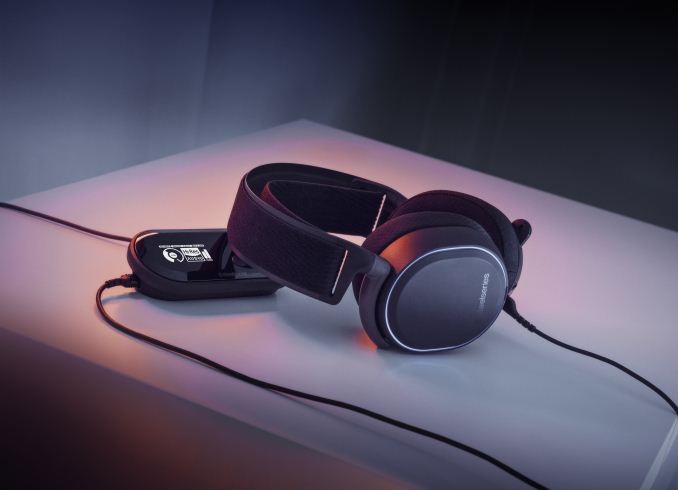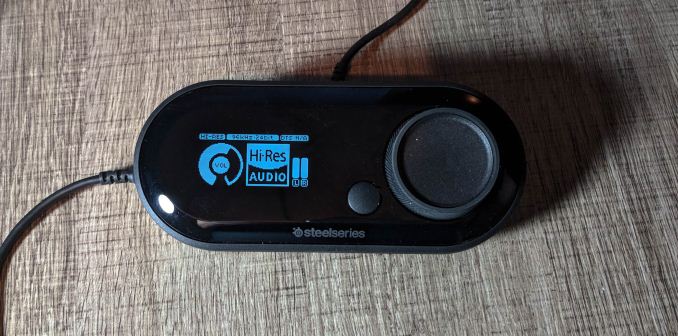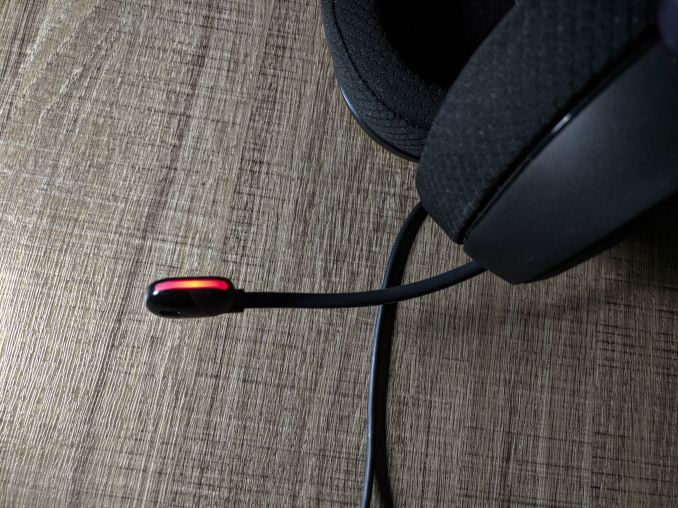The SteelSeries Arctis Pro Gaming Headset Lineup: GameDAC Or Wireless
by Brett Howse on March 13, 2018 9:00 AM EST- Posted in
- Headset
- Audio
- SteelSeries
- Accessories
- Arctis Pro

SteelSeries is a well-known manufacturer in the PC accessory space, and have been in the gaming headset market for some time. Today they are launching two new products at the top of their Arctis lineup, and both of them offer some interesting new features. The first is the Arctis Pro + GameDAC, which is the first Hi-Res Certified gaming headset on the market. The second is the Arctis Pro Wireless headset, which takes many of the features of the wired model, and adds wireless to the mix. We see a lot of accessory announcements, but when SteelSeries briefed us on these two new headset models, there was a lot of interesting technology they were bringing to the table, which is always something to get excited about.
The Arctis Pro + GameDAC is really the star of the show. SteelSeries has recognized that the majority of people use onboard audio, and although a few motherboards do ship with high quality audio components, the majority do not. SteelSeries has an answer to that problem with the GameDAC, which is a USB DAC (Digital to Analog Converter) and amplifier which has been tuned specifically for the Arctis Pro headset. We’ll dig into the GameDAC in a bit, but there’s a lot to like here.
Both the Arctis Pro wired and wireless model both feature the same drivers, which SteelSeries has said are the highest quality drivers they’ve ever used in a gaming headset. They feature neodymium magnets, and can produce frequencies from around 10 Hz to 40,000 Hz, which you’ll notice is both well below and well above the thresholds for human hearing. This gave them some flexibility in tuning the response.
| SteelSeries Arctis Pro Lineup | |||||
| Component | Arctis Pro + GameDAC | Arctis Pro Wireless | |||
| Compatibility | PC and PlayStation 4 | ||||
| Speaker Drivers | 40 mm Neodymium | ||||
| Headphone Frequency Response | 10 Hz to 40 KHz | ||||
| Headphone Sensitivity | 102 dBSPL | ||||
| Headphone Impedance | 32 Ohm | ||||
| Headhone THD | < 1% | ||||
| Microphone | Bi-directional noise cancelling | ||||
| Microphone Frequency Response | 100 Hz to 10 KHz | ||||
| Microphone Sensitivity | -38 dBV/Pa | ||||
| Microphone Impedance | 2200 Ohm | ||||
| Audio Formats | Hi-Res Certified 24-bit 96 KHz | 16-bit 44 KHz Bluetooth 4.1 A2DP, HFP, HSP |
|||
| THD + N | < 0.0032% | Not Rated | |||
| Box Contents | Arctis Pro Headset GameDAC Main Headset Cable USB Audio Cable Toslink Optical Cable 4-Pole 3.5mm adapter Microphone Windscreen |
Arctis Pro Wireless Headset Transmitter Base Station USB Audio Cable Toslink Optical Cable Mobile Audio Cable Mobile Charging Cable Microphone Windscreen |
|||
| Price | $179.99 Headset Only $249.99 Headset and GameDAC |
$329.99 | |||
SteelSeries officially promotes the Arctis Pro models as headsets that work on both the PC and the PlayStation 4. Xbox will work with audio only. Both models do come with a 3.5mm headset adapter as well, for connection to almost anything, and assuming you have a newer model Xbox One controller, this would also provide full headset capabilities.
SteelSeries also offers the ClearCast microphone on both of the Arctis Pro headsets we’re looking at today. ClearCast is a bidirectional microphone setup which offers active noise cancellation. With a bidirectional microphone, noises that are heard on both sides of the microphones can be cancelled out, since they are likely background noises, which leaves your voice stronger and clearer, without sounds from outside that window having much of an impact on the sound recording. In practice, this setup is very effective. Sounds from the keyboard are muted, and noises further away are completely eliminated.
SteelSeries is replacing their older Siberia 800 and 840 models with these new ones, and will be offering three combinations. You can get the Arctis Pro headset only, the Arctis Pro + Game DAC combo, and the Arctis Pro Wireless. These aren’t inexpensive headsets, but neither are they the most expensive models around. But to see if they are worth the asking price, we first must check out how they fared in the couple of weeks of testing.












32 Comments
View All Comments
aleny2k - Wednesday, March 28, 2018 - link
This is an un-sponsored comment made by my own personal opinion, and speaking on behalf of many people out there who just read this article/hands-on/review, benefited from it, but kept silent or does not give any feedback: I really do enjoy reading through this article and I do learned a lot of information that was not given directly by the manufacturer (and information which cant be found on other websites). Although I must say I was actually hoping there would be more comprehensive content and in-depth review, but since this article never did set out to be a review nor hands-on in the first place, all is forgiven. Please keep up the good work and hopefully, this will not be the last time you dip your toe in the water for headphones.blackmagnum - Thursday, March 15, 2018 - link
Check techpowerup for a second opinion on the same product.Dr. Swag - Tuesday, March 13, 2018 - link
Is this sponsored? Because it sure feels like it but it doesn't say so...Ryan Smith - Tuesday, March 13, 2018 - link
No, it's not.Brett is a closest audio enthusiast and wanted to try out some headphones. That's all.=)
JDBeast - Thursday, March 15, 2018 - link
Almost lost me at the very beginning..."the GameDAC, which is a USB DAC (Digital Audio Converter)"
DAC is Digital-to-ANALOGUE Converter, it's not just used for audio, though that is most common.
Luckily I checked later in the article and it looks like this was a first draft error, as it is correctly explained in the GameDAC section.
JDBeast - Thursday, March 15, 2018 - link
Also I would be curious to know if they have address the screen burn issues with their oled displays. I have the Steelseries Wireless N with basically the same breakout box and it has bad screen burn after a couple of years use. It doesn't affect performance in anyway (of course) but it looks bad and has ruined the resale value of my headset.Brett Howse - Saturday, March 17, 2018 - link
DAC can be referred to as either, but I prefer the original Digital to Analog Converter. I had been reading some press material which referred to it as Audio Converter which made me type that - I fixed it now.halcyon - Friday, March 23, 2018 - link
For those who are wondering... The GameDac is a 2 channel soundcard for Windows.This means it can NOT do proper mutichannel to 3D sound virtualization as ir is being fed only stereo signal.
It will not be able to do proper front to back identification of sounds in 3D games, unlike DTS Headphone (Asus), Creative Sound Blaster 5.1/7.1 cards or Sennheiser GX1000 series.
All it can do is some pseudo room feel with echo/reverb/phase.
i.e. not a true, high end, 3D sound card.
The article should make this very clear.
TechPowerUp review author rates GameDAC below all modern multichannel 3D virtualization sound carda foe gaming directional cues.
Thats what matters in 3D and FPS games.
aleny2k - Wednesday, March 28, 2018 - link
Hi Brett, thank you for the informative hands-on of this product, information which was not provided by their official website or other sites for that matter. I enjoyed it very much. I do have a question about the Arctis Pro Wireless. You did mention that it can be used wired through the gameDAC as well. My question is, do you get exactly the same audio quality (and hi-res Audio) that you get from Arctis Pro+GameDAC, when you wire your Arctis Pro Wireless to the GameDAC? Steelseries is claiming they are using the same speaker and driver for all their Arctis Pro models. Just that because the wireless variant is wireless, it has more noise and distortion and could not achieve the same high audio fidelity as the wired edition (even though SS claimed that wireless can produce lossless audio), mainly because wireless signal is compromised (compressed and distorted) as well as the built-in DAC found INSIDE the Arctis Pro wireless simply isnt ESS Sabre 9018. Technically, when using the wireless headset through the 3.5mm analog wire, it bypasses the built-in DAC found inside the headset, thus emitting the native audio signal from the source without being tampered by the DAC. But since I dont have the headset to test with, I was wondering if you have some answers for this question. I do have a separate DAC and also a couple of audio devices that are capable of producing lossless, hi-res audio. So I was wondering if the Arctis Pro wireless can behave EXACTLY like the Arctis Pro+GameDAC when being used wired. thank you!!Brett Howse - Sunday, April 1, 2018 - link
The Wireless model has the exact same drivers, and the same connectors as well, so you can just plug it in as if it was the wired model and it does bypass the built-in DAC. You can run it without turning on the battery powered circuitry so it sounds just like the wired model when hooked to the DAC.You can also use a 3.5 mm if you want to do the same thing.